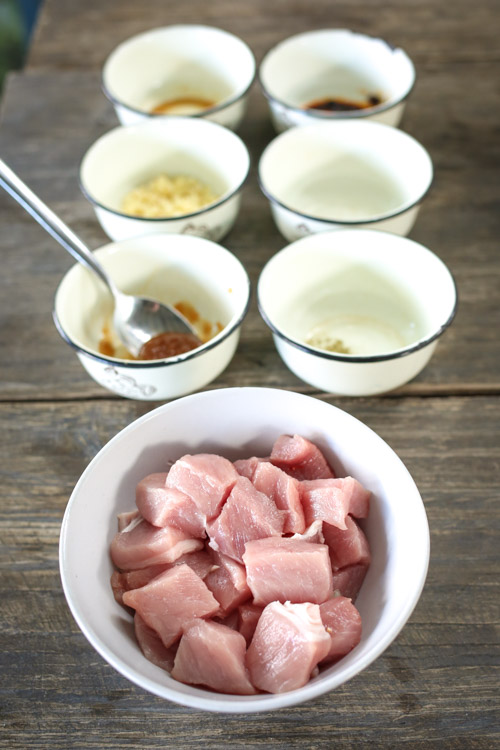
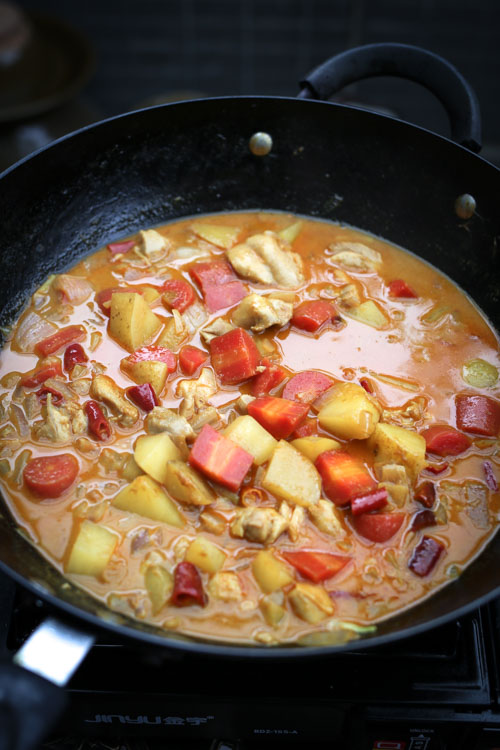
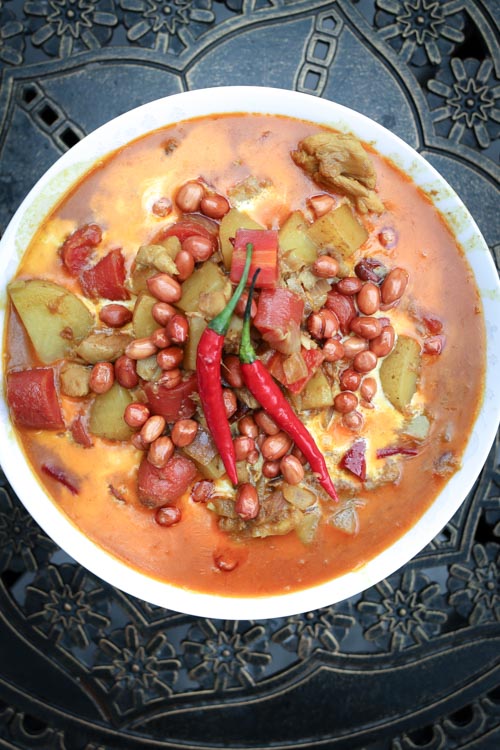
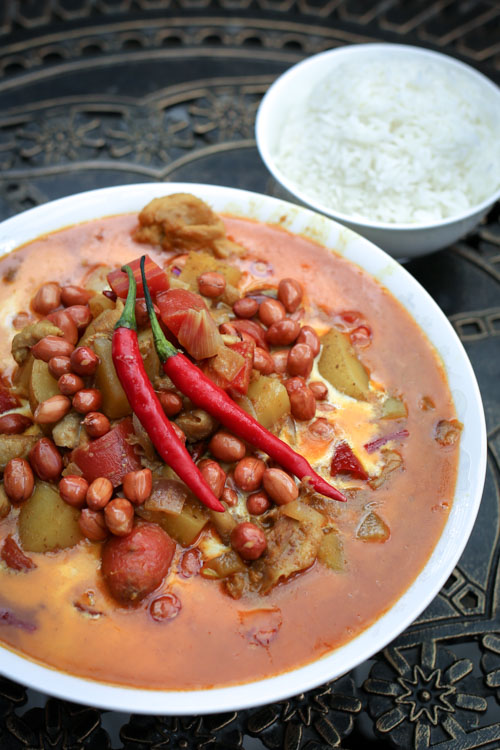
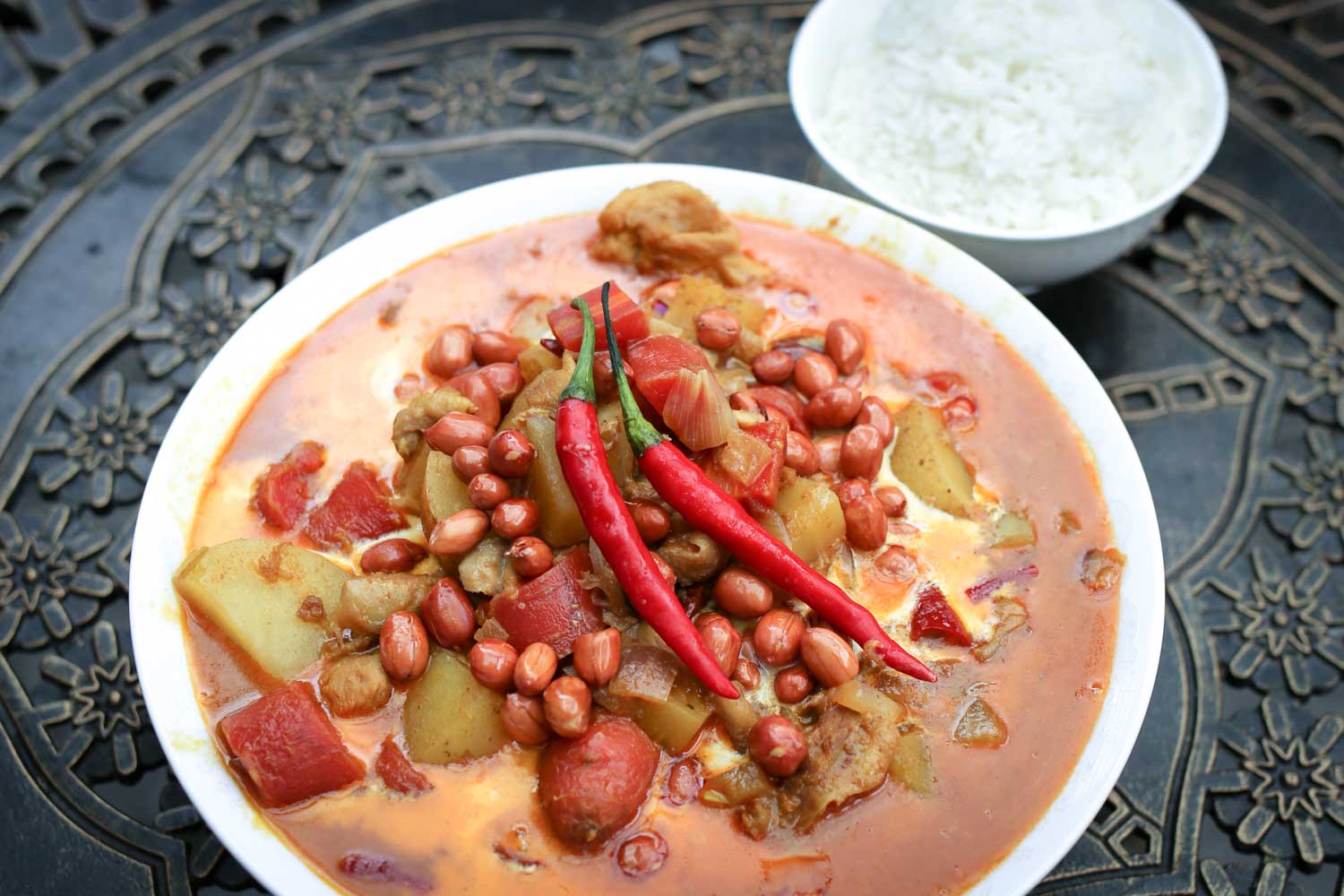
Pin it
Share it
Many dishes believed to be deeply connected to one continent is inextricably married to the other. From the Americas, Asia received pineapples, peanuts, potatoes, sweet potatoes, corn, cashews, tomatoes, and chilis, and peppers in all their stunning variety. In return, the Americas got rice, bananas, plantains, limes, oranges, cilantro, coriander, onion, green onion, garlic, and cinnamon.
As Portuguese traders made their way up the Asian coast, to Mexico, and then home to Europe, their worldly tastes and cargo came with them. A classic Portuguese stew soon became re-invented in every port, consisting of potatoes, carrots, chilis, in some local gravy served with rice. Go to India, Malaysia, Thailand, Japan, the Philippines, Mexico, and Portugal, and you will find one iteration of this stew, they have many names today ( red curries, brown curries, afritadas, and kalderetas) This one is Cambodia’s.
This is one of those recipes where everyone swears their Grandma does it best. This is one of our Cambodian team member’s grandmother’s recipe, who she swears makes the best one in the country. Her Ma’ Oni (who liked to be called Mother Oni instead of Grandmother as it made her feel old) liked to make this when baguettes had gone stale, and used huge whole chicken drumsticks. You could eat and dip the chicken with one hand and sop up the curry with the crusty bread, and get lovely crunchy bits of peanuts in the end. This was often eaten sitting on the tiled floor in front of the a VCR and television that had seen better days, tucked away in a small alley apartment near the palace. This was well before the days Western-style dining tables permeated urban culture. It has been passed down for generations from the province of Kompong Svay, and now we hope you enjoy it in your home as much as we have in our own.
Recipe Note:
Please note this recipe is designed with our selected curry paste in our Cambodia food box. Your supermarket or online retailer variety probably isn’t going to be good, and curry powder is not the same thing at all. This is not your Indian curry, and it shouldn’t have shrimp paste or other opt-ins you see in Thai curries. Kreung is a paste mix of aromatic ground spices that start out many Cambodian recipes, including curries. So although this box is labled “Yellow Curry Paste,” by all intents and purposes it is, in fact, a kreung. A typical Cambodian household can easily go through 6 cups of this a month. One of the key differences between Cambodian cuisines and other regional cuisines is the omittance of shrimp paste- it’s not used widely in Cambodian cuisines but is a staple in neighboring Thailand, Vietnam, Malaysia, and the Philippines.
We selected this particular “curry” paste because it doesn’t have shrimp paste (or any animal products) and is the most authentic kreung available outside the Kingdom of Wonder. The included ingredients are primarily lemongrass, kaffir lime leaf, and galangal- the holy trinity of Cambodian aromatics. It also has staples like turmeric root, garlic, and shallot, which are mainstays in homemade kreung. In the box recipes included, you will be using this as a base kreung with modifications made specific to each recipe.
Heat is up to you, here in Cambodia we add so much chili (or at least it’s skin) that the curry turns red, so it’s simply called “Red Curry.” We use what locals call bird talon chilis, because of their shape and size, but also because they can cut into you like a falcon. These tiny guys are smaller than your pinky and around 100,000 SHU. Just to give you a frame of reference, a jalapeño pepper is 2,500-8,000 SHU. We use a bunch in the curry, and serve it up with raw chilis to nibble on in between bites. If you’ve joined our tours- you know what we’re talking about!
There is already some of this chili in the curry paste, but not too much- which is why it’s only yellow, not red! It’s already mild/medium spicy so only add extra if you’re pretty confident with your heat tolerance. We like enough to make our noses sweat.
When it’s cooking, the spice level will definitely be different from the final product. Test out the heat level at the very end after you remove the curry from heat, and take the trial bite of the curry with the vegetables and chicken- don’t just sip the curry itself otherwise it will seem too hot. Everything will be eaten together and the starchy cooked ingredients tone down the curry quite a bit. If it’s too hot, add more coconut milk. If it isn’t, add more chili (you want to sweat just a little.) It’s about balance.
It should be quite spicy to your taste buds when you’re doing your taste test at the end, it will become slightly milder when you serve it. As you eat, your mouth will warm up to it and you can appreciate the flavor of the chili skins. If your face isn’t sweating a little bit, you aren’t doing it right! It’s called red curry for a reason.
Ingredients
2 Tbsp oil, or just enough to cover the bottom of a pot.
50g / 1.75oz of yellow curry mix
500g / 1lb of meat (typically a whole chicken cut into pieces bone-in, to the family’s preference of size. Some people like bite-sized chicken breast, others prefer whole drumsticks)
2 medium or one large potato — peeled & diced
2 medium or one large carrot — peeled & diced
2 medium or one large onion– peeled & diced
Optional throw-ins/substitutions: squash, pumpkin, eggplant, sweet potato — bite-sized
2 Tbsp fish sauce
2 Tbsp palm sugar
Dried chilis to taste, seeds removed, unless you like it very spicy. See notes. These will give it a beautiful red color, so use as much as you can handle.
400ml / 14oz chicken or vegetable broth
400ml / 14oz whole coconut milk – set aside ¼ cup for garnish at the end (shake carton vigorously)
1/2 cup crunchy peanuts, roughly chopped up or smashed with a mortar and pestle to your desired size
Chili and fresh basil for garnish
Steamed white rice and/or a toasted-till-very-crunchy baguette (both is good)
Directions
Sign up for more recipes!
Email: info@lostplate.com
China/Thailand/Vietnam Tours:
+86 156 9210 9030
Portland Tours:
+1 503 409 5593
WeChat: lostplate

Join our newsletter for promotions and tour announcements!